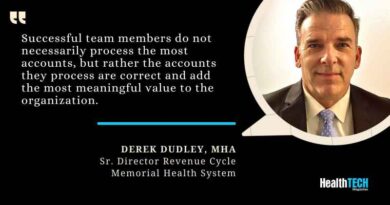The Power of Numbers and Dashboards: A Data-Driven Strategy for Optimizing Revenue Cycle Management
By Ahmad Kilani, Medical Director and Nicholas Libertin III, Enterprise Physician Advisor, Cleveland Clinic
The rise of physician advisors has been a transformative development in 21st century healthcare. Many healthcare systems have adopted an enterprise physician advisor model to streamline workflows and enhance efficiency, moving away from reliance on individual hospital-based advisors. This change allows physician advisors to support multiple facilities and optimize operations. As healthcare systems continue to merge or expand into larger networks, the need for standardized revenue cycle management (RCM) practices becomes increasingly critical.

As physician advisors, our responsibilities include utilization management, denial prevention, and revenue cycle optimization. We take pride in our data-driven decision-making approach, especially in managing the revenue cycle. Collaborating with robust analytics teams, we meticulously track various metrics, such as length of stay per provider or service line, readmissions, peer-to-peer overturn rates, and insurance denials. These examples illustrate the data we use to perform our roles effectively. The implementation of automated bots to handle repetitive tasks and the creation of user-friendly dashboards have allowed staff to focus on more complex and high-value activities.
With the abundance of big data, selecting the right data to create the most significant impact is crucial. It is easy to become overwhelmed by extensive tables with countless rows and columns. The key is determining which data should be utilized and which should be set aside. Online dashboards, which enable instant data review and sorting as needed, have greatly simplified this process for users.
We can deliver high-quality care while maintaining financial stability by leveraging advanced analytics and standardizing processes across expanding healthcare networks.
A core function of physician advisors is denial management. A comprehensive dashboard that tracks denial cases selected for peer-to-peer review and appeal, along with their outcomes, enables a more efficient and balanced workflow. Both payers and hospitals can use the dashboard to dissect data, identify trends, and monitor expected versus actual reimbursement. This valuable information can pinpoint denial categories and their root causes, leading to educational opportunities to improved documentation and adherence to evidence-based medicine, ultimately reducing the administrative burden on providers and payers.
Utilization management benefits significantly from dashboards that assist with status management and identify areas for improvement, such as incorrect status selection on admission, which can lead to denials and compliance issues, especially in short-stay cases. Accurate status selection ensures better revenue and avoids unnecessary denials and out-of-pocket patient costs. Additionally, these dashboards monitor denials by location and payer, identifying trends and patterns among payers with high denial rates. This facilitates discussions between providers and payers about high denial rates and their causes compared to similar payers, encouraging process improvements such as data exchange method with payers.
A Resource Utilization dashboard identifies how services are used across hospitals, departments, nursing units, or outpatient facilities, helping control utilization and direct resources to areas with higher demand. This improves resource management and reduces costs. Physician advisors often lead utilization management committees and conduct discussions to optimize resource utilization.
Care management dashboards facilitate discharge planning. A dashboard that tracks the number of patients discharged home with and without home care versus post-acute facilities provides a better understanding of post-acute denials, streamlining discharge distribution, or improving documentation to support the need for such services. The dashboard also allows monitoring of precertification times and designing process improvement plans to reduce these times. Physician advisors play a crucial role in supporting care management, especially with complex discharges.
Observation of patients is increasingly attractive to health systems, given the growing frequency and the ability to manage some patients in outpatient settings with appropriate resources. Established benchmarks for observation cases are lacking, especially since each facility may have different case types, making it challenging to create standard and reliable benchmarks. Several metrics can be included in an observation dashboard, such as cost per case including direct and indirect cost, length of stay, number of consults per case, conversion rate, ancillary services performed, relevance to the acute presentation, and how quickly they were performed. Data can be reviewed by payer, diagnosis, location, and provider, helping improve efficiency and identify outliers. This data also supports the case for observation units and monitors their effectiveness and productivity.
A Medical Staff Scorecard/dashboard is a valuable tool for providing feedback to providers, including physicians and advanced practice practitioners. Many providers lack access to performance data. A dashboard that displays the length of stay, procedure times, time to round, and ancillary requests provides valuable insights for physicians to understand their performance and compare it to their peers using risk-adjusted data. The scorecard helps reduce inappropriate utilization and enhances success in value-based programs. The quality section of the dashboards can include the number of preventive services, medications used, chronic disease management, and vaccinations, enabling physicians to practice better population health management and prioritize care for those who need it most. The scorecard can also include readmission data, helping providers identify opportunities, create mitigation plans, increase access, and collaborate with other services such as care coordination.
The potential for utilizing data is limitless. Dashboards allow administrators, caregivers, and medical staff to monitor outcomes and make necessary adjustments without missing opportunities. This reduces costs, waste, and administrative burden while increasing efficiency and access to healthcare. A data-driven approach and commitment to continuous improvement ensure an enhanced revenue cycle and reduce denials and controllable loss. We can deliver high-quality care while maintaining financial stability by leveraging advanced analytics and standardizing processes across expanding healthcare networks. Physician advisors involved in these tasks cannot emphasize enough the value of having this data available and updated instantaneously.



